|
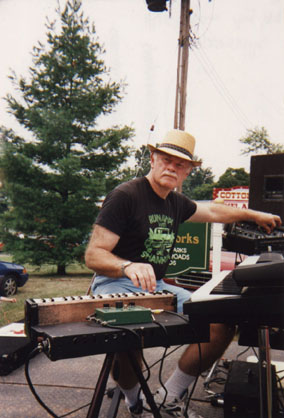 Max Crook, professionally known as Maximilian, was one of those recording artists who was terribly underrated. Not only was he a musician of unspeakable talent, he was a dreamer, a visionary. He had an idea in his mind that stayed. It was a totally new concept in music. Something unique. Something extraordinary. Synthesized electronic music. Some praised him for bringing it to the forefront of rock and roll. Others eternally condemned him for it, and for where it would eventually lead. Like many young men and teenaged boys, Crook enjoyed tinkering and dabbling with electronic devices. The difference was that Maximilian would turn his dream, his vision of what music in his mind should be or become, into a reality. The son of Dr. Clarence and Helen, Maximilian was born Maxfield Doyle Crook in Lincoln, Nebraska on November 2, 1936. Life in the Crook household was one of upper middle class. His father, a polished and well-mannered individual and a successful surgeon, raised young Max on standard recordings of the day.  Crook developed an interest for music in junior high. His parents bought him an accordion, the first instrument Max learned to play. Taking lessons from a strict German teacher, Crook's first lesson taught some fingering. But Max struggled while trying to learn scales and read music charts. He soon found he had a gift for picking up more complex and popular music by ear. At his next lesson, Crook wanted to impress his accordion teacher by playing "12th Street Rag" with a "new" arrangement. This was not acceptable and to the liking of his teacher, and with time it became increasingly difficult for Max to stick to the basics. So he quit, and focused on other interests in high school, including becoming an excellent diver on the swim team. Graduating from Ann Arbor High School in June of 1954, Crook left Michigan for Albuquerque and enrolled in college in the fall of '54 at the University of New Mexico. "I took up a class called 'Beginning Piano,'" Max recalled. "I flunked it! I still have the report card! Part of the reason for that was the fact that I broke into their practice rooms at night and just played and played and played. All of a sudden, there appeared these nicely written signs on all of the practice pianos: 'The playing of popular music will not be tolerated on these instruments.' So that was the end of that. Now I could only play on the dorm piano." Crook's reason for leaving Michigan for college was as one might expect: "to get away." He wasn't trying to get away from his parents, however. He left Michigan due to a recurring seasonal allergy problem that his body could not seem to kick. "That's why I moved to New Mexico. I was told that 'it's the place to go' to get rid of allergies. Well, I never did lose them," he admits today. "I still have them, but at least they're not as bad as when I lived in Michigan. I moved to California in the late 60's and have just recently moved back to New Mexico." Max studied at the University of New Mexico from 1954 - 1956, then returned to Michigan to finish his schooling. He enrolled at Western Michigan University in Kalamazoo where he attended from 1957-1959. "It was on campus at WMU that my roommate, Stan Martin, and I formed a group we called The White Bucks, remembers Crook. "We were a great five-piece combo. We played rock and roll, boogie, and honky- tonk. Whatever appealed to the kids at the time. And the high schoolers, oh man, they went nuts! The girls would scream at the top of their lungs at record hops. It was insane. Stan played bass, Eddie Lynch played guitar, Brian Woodworth was on drums, Tom Sabada played sax, and I was on the piano. Before we got Tom Sabada though, we had a guy by the name of Norm Murdock who played sax. But he quit school. He had the craziest laugh I have ever heard, and naturally, we made use of it. We utilized what we dubbed his 'hyena laugh' on one of our recordings." A good looking and tight playing group, The White Bucks wore red tux jackets with black satin lapels, white shirts, black bow-ties, black tuxedo pants, and white buck shoes -- hence the name. Graduation and personal bickering between band members combined effort in breaking up the group. It was time for "the real world" and each member went his own seperate way. It was around this time that Max asked for Joann Stollsteimer's hand in marriage. In the summer of 1959, Max Crook continued toying with electronic gizmos that he had developed a liking for in school and eventually built his "claim to fame" device, the Musitron. The Musitron was built solely for the purpose of being used as an adjunct to the piano for Crook. It was never intended to be constructed for commercial use or sale. Max built his device out of television tubes, resisters, parts and pieces from old amplifiers and reel-to-reel tape machines. It was a wonderful machine, able to produce mellow and subdued voices, sweet organ tones, piercing and raspy notes. With inboard and outboard modifications, the keyboard was able to "bend" notes (as demonstrated on "The Twistin' Ghost" and "Don't Gild The Lily, Lily"). It had a frequency range of two cycles per second to the top end of beyond human hearing. A shrilling, shreaking, haunting machine, the Musitron had one major setback that would label it prehistoric: It wasn't polyphonic. In other words, it was a single-note playing organ, able to produce only one note at a time. Crook admits he never perfected the machine to his highest expectations, but he did manage to develop techniques which sounded as if harmony notes and chords were achieved (i.e. "The Twistin' Ghost" and "Bumble Boogie"). This was also another major factor in Crook's developing of a multi-channel tape recorder. 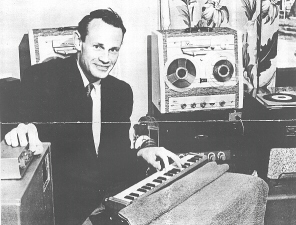
The first session that Max used his Musitron for was a session at Berry Gordy's studio in Detroit in the late summer of 1959. The session yielded "Beez Wax," a Crook original, and "Bumble Boogie," an old and familiar tune with Crook's new arrangement. Incredibly, Max was two years ahead of the game with his arrangement of "Bumble Boogie" which, in his mind, was thought to be a sure-fire hit. Unfortunately, the magic needed to get it to a label and out on record weren't made, and the composition was shelved along with "Beez Wax." "We cut two arrangements of 'Beez Wax' in the studios," recalls Max. "We had two good takes down on tape that I was happy with, but still there was something missing. We changed it a little on a later take, spiced it up and uptempoed it just a bit, and it came out terrific. I was pleased. I thought up a new solo for the middle of it, which later I incorporated into the solo for Del Shannon's "Hats Off To Larry," because my number never got out, so I figured it may as well get used on something, so I stole it off one of my earlier recordings. Well, it turned out that Harry Balk didn't want to use this solo for "Hats Off To Larry." He had something else in mind. So we wound up using this solo with the bending notes on it's flipside, "Don't Gild The Lily, Lily." And I think, to this day even, it's the second best bridge I have written to date, behind the one on "Runaway" of course. Max became devasted when, in 1961, a group called B. Bumble and the Stingers came out with a hit single titled "Bumble Boogie." "I had the conception first," Crook said displeasingly, "Ahhh, that hit could have been mine. But that's the record business I guess. Win some, lose some." 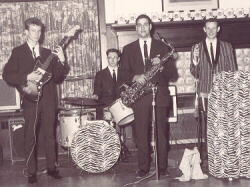 Those fortunate few who have heard Max's version of "Bumble Boogie" agreed that it had great potential and many agree it superior to that of the Stingers' waxing. Crook used multi-channel technology to get four Musitron 'voices' used on his recording. "I bought a reel-to-reel tape recorder in '59 that I constructed into a crude four-channel, or 'four-track' tape recorder," explains Max. "I bought stereo heads for it and mounted them in a staggered position so that it would allow me to record four seperate channels simultaneously. I mounted the stereo- and erase- heads so that when the tape passed across it, it would take four channels of sound. That was my first four-track machine, and I used it an awful long time. This allowed me to deal with the Musitron's problem of being a monophonic instrument. I could record a track using one 'voice,' rewind the tape and accompany it with a second 'voice,' and do this a third and a fourth time around, never losing any fidelity. I began doing this heavily with Del Shannon at the Hi-Lo Club around 1960. That's when I finally played the Musitron before a live crowd. The only other times I had used it 'live' were at Battle of the Bands functions and things of that respect." Max Crook joined Del Shannon's "The Charlie Johnson Band" at the closing of 1959. The Musitron became the centerpiece of the combo, and would later become a staple in Shannon's early hits. Crook played with Shannon and bandmates for about two years at the Hi-Lo Club in Battle Creek before Shannon's discovery, and was willing to share his recollections of the old club: "It was a rough club, that's for sure. Especially on Friday and Saturday nights. Whenever a fight would start, it usually broke out somewhere in the back end of the place and work it's way up to the stage. The patrons would tear the place apart, throwing bottles at each other, fist-fighting, and hurling each other over poor unsuspecting tables. When a fight would break out, we would all just walk off stage and wait for the fight to subside, and then we'd walk up on stage and plug in again. At this time, Del was not a patient individual. He was very impulsive. A common thing that Del would do was to pull the plug out of the jukebox that was along side the stage, and then he'd begin his set. When the set was over, he would plug it in again. So you would always hear this song break down...Del wouldn't wait for the song to finish on the jukebox. This caused some friction with a few regulars, and put Del in a situation that he could have so easily otherwise avoided. Del was a great guy with a great personality, anyone could befriend him. But he was a guy you couldn't keep focused. He'd sometimes start writing these good songs, but then wound up never finishing them up for one reason or another. He would lose interest in them. Usually it was due to the extreme mood swings he'd have. "The floor of the Hi-Lo Club was long and narrow, booths on each side, and the ceiling had colored indirect lighting that was oval in shape. The place looked like a ballroom out of the 40's. The stage was a mere six inches off the floor, so you can easily understand our fear of the place when fights broke out. It wasn't a high-set stage by no means! But it was a job. Whether it was fun playing there or not is hard to say. The mind sometimes plays tricks on you. I enjoyed the music and fellowship, but I never really mingled much with the regular folk there. I was never a drinker. In fact, some of the people thought I was just plain weird! I had this ritual of coming in with my kool-aid and cookies and a little transistor radio to listen to the Detroit Tigers (baseball) games between sets, or sometimes even while I was playing the piano! I made $48.00 a week at the Hi-Lo Club, and $18.00 for a six hour gig at Daisy Mae's Tavern on Sundays, where we would play strictly country and western music. Del loved that! I remember that the Gilberts (who owned the Hi-Lo Club) were so cheap that we only had our drummer, Dick Parker, on Friday and Saturday nights. Wednesdays and Thursdays we were short a drummer. It was just Loren Dugger, the bass player, Del Shannon on guitar and vocals, and myself on keys. "Loren Dugger, or 'L.D.' as we called him, was quite a drinker. A booze-hound he was. He had a string bass with a contact microphone attached to it with tape. Dugger was always tired when he got to the club, from working all day at a tire shop. His hands were always grodey. Half the time he would fall asleep while we were playing. All of a sudden, there wasn't any bass! So Del, Dick, or myself would have to yell, "Dugger!!!" "Huh?" Boom-ba-ba-boom, and he'd start up again. But sometimes, and I swear on this, Dugger would be half asleep and still be playing the bass! I've never seen anything like that, before or after. "The Gilbert Hotel was the hotel above, the Hi-Lo being down below on the first floor. The 'big Hi-Lo,' where we would play, could seat about 300 or 400 individuals. It had a stripped wooden floor with a dome shaped ceiling. 1930's architecture with the 50's neon. There were no chandaleers, this was a dive! From the street side, you could walk in (on Capital Avenue) and there would be the bar there. You'd have to walk through this first club, 'The Little Hi-Lo,' to get to the bigger club. A vacant factory was across the street where a hotel now stands. I never saw the factory up and running myself. There were parking lots next door to the factory, and that's usually where we would park because there was no place to park in front of the Hi-Lo. Sometimes we would walk into a side door (where minors would sneak in) that faced to the right of the club (on Waters Street). There were no buildings directly to the right of the Hi-Lo. To the left, there were a few small stores, but I can't tell you what they were because I never went in them. I just came to the Hi-Lo to play and work, and immediately left for home afterwards. I didn't stick around or go to the other bars down the road after. "On Waters Street, there was an alley with a garage there, where Philip "Pa" Gilbert would park his car. He bought himself a Cadillac which was a little to long for the garage. One night, when we were on a break from a set, old man Gilbert was backing his car in the garage, and he bumped the garage in back where the stage was on the other side. He ran into the wall, knocking down Dugger's bass in the process, whereby breaking the neck on the string bass. Dugger wound up having to fix it himself. Gilbert was too cheap to offer to fix it for Dugger!" When asked what songs they actually played at the club, Crook replied: "Just about everything. We played Duke Ellington's 'Caravan' many times. 'Mood Indigo.' 'White Silver Sands.' 'Handy Man' I remember playing several times, in Jimmy Jones' fashion. Conway Twitty's 'It's Only Make Believe.' Del really loved that song. Some Hank Williams compositions and such, Fats Domino. Some Jerry Lee Lewis numbers. 'Rock Around the Clock.' We played a lot of Chuck Berry tunes. You had to do them in those days or else you weren't considered a rocker. We didn't play too many originals for the crowd though, as I recall. A recording contract was foremost in Del's mind, and he didn't want anyone by chance stealing anything he wrote. In those days, we were writing songs, but we didn't have anything copyrighted before getting with Harry Balk and Irving Micahnik. So we mostly performed the hits of the day. I do remember that we played Del's 'I'll Always Love You' quite often. It was a good emotional-type song for him to sing, and in my opinion was a lot better than 'The Search.' Those were the two songs Del had professionally recorded, and he was proud that he had done so. So he played them for the crowd." So were the times at the ol' Hi-Lo Club. Be it good times or bad times, it was a fundamental learning and growing process for them all. When Del Shannon left the Hi-Lo for good in March of 1961, Max Crook took over as front man and christened the new group "The Maximilian Band." Crook kept the remaining players of the Big Little Show Band and added a guitar player to replace Shannon. "The Maximilian Band" continued it's venue there throughout 1961 and early '62, whereby that time Crook had three singles to his credit as "Maximilian." Crook brought in a man named Mayf Nutter to take over as front man, as Crook didn't have much of a singing voice. The band changed over as country and western and evolved into a country bar once again. Crook left the group in late '62 as he had achieved status locally as a proven musician. He became greatly in demand at many local functions and played good paying gigs around the midwest for the next two years. Mayf Nutter was left to carry the band at the Hi-Lo and Nutter eventually gained some recognition as a national country singer with minor hits and acting parts. Crook continued his travels as "Maximilian" and his road band changed a bit with Frank Vella on the saxophone, Bob Hudson on guitar, Dick Parker still on the drums, and Max himself on the piano and Musitron. Moving back to Ann Arbor, Crook didn't want to drive a distance to a regular gig as he had in the past with the Hi-Lo, and so he found himself leading a group at The Rathskeller, a German basement dive halfway between Ann Arbor and Ypsilanti, Michigan. By this time, it had occurred to Max that "Maximilian" might not achieve international fame and fortune as he had hoped. So he studied and analyzed Del Shannon's career. After all, Crook was an integral part in the construction of "Del Shannon: Superstar." Could he repeat this success with another talented singer/songwriter? Max finally had gotten wise as to how the record business was played, learning quite a bit about the business from Ollie McLaughlin on how to publish compositions, starting record labels and producing from Harry Balk, and managing artists from Irving Micahnik. Crook was approached one day by a man who called himself Ronni James. The timing was perfect. Crook became the clever devil and swiftly started up his own label, "AA Records ("Double A" Records, standing for Ann Arbor)." He signed Ronni James to an exclusive recording contract, brought Ronni into the basement of his home where he had set up and built his own studio, and recorded to James originals, "Daydreaming" and "Hey! Little Stranger." The records were country-rock and obviously spin-offs from two earlier Del Shannon compositions. Both sides by Ronni James included special accompaniment by Maximilian, the A-side having inclusion of the Musitron, giving it that authentic "Shannon- feel." The idea was not original, as by that time everyone seemed to be borrowing or trying to immitate the "Shannon sound," and Crook was no exception. The Ronni James effort proved to be unsuccessful for a number of reasons, but not because the songs were weak per say. Max lacked the promotion, distribution, and finances to get the single off the ground. Crook and James were sour, thus bringing "AA Records" to it's dismissal. The exercise proved to be a valuable lesson and learning experience for Max. Harry Balk was right about two things he preached: "A lot of things need to come together to make a record a hit. Magic is one of those things..." and "Be a leader, don't be a follower..." 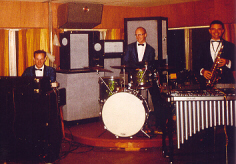 Maximilian perservered; he would not give up so easily. Crook continued to write and record instrumentals. "Maximilian and His Band" continued to play gigs around Ann Arbor and Detroit, sharing the bill with Danny Wayne and Doug Brown & The Omens, who later evolved into Bob Seger & The Last Heard (both Brown and Seger hailed from Ann Arbor). By the mid-60's, Crook evolved into a new kind of music, electronic "big band" music, but as a two-piece combo. Max met a man named Scott Ludwig and together they would form the group "The Sounds of Tomorrow." Crook, for the first and only time, shared his Musitron technology with Ludwig, who developed another synthesizer invention similar to the Musitron which he dubbed a "Sonocon." The Sonocon basically had the same features as the Musitron, but included more up-to-date electronic components that enabled this keyboard to partially electronify Ludwig's drum set. This allowed Scott to free one hand from the drums for keyboard work. Together, with "Maximilian on the Musitron" and "Scott Ludwig on the Sonocon," they played gigs around eastern Michigan with regularity and to some success. The two wrote and recorded many instrumental compositions in hopes of landing a recording contract, but to no avail. > Scott Ludwig became the first individual in the state of Michigan to purchase a Moog Studio Synthesizer in 1968, and together Crook and Ludwig continued their joint effort performing and recording "space age" music. Between the two musicians, they such a vast amount of electronic equipment that a U-Haul truck was necessary to haul their musical equipment from gig to gig. Their music consisted of everything from Glenn Miller to "Telstar." Favorites in their sets included Tommy Boyce and Bobby Hart's "I Wonder What She's Doing Tonite," "Caravan," "House of the Rising Sun," and "Winchester Cathedral." Max Crook eventually got weary of the cold Michigan winters and his allergies acting up on him, and so he made the pilgramage to California, "land of everlasting sunshine." There, Crook settled down with his family in Canoga Park. He became a burglar alarm installer (no surprise!) and eventually became a full-time firefighter. But he never lost interest in his music. In August of 1969, Crook invested some of his money into a Moog synthesizer also. Paul Beaver, the salesman who sold the Moog to Max, offered a 12 week course to teach new Moog owners how to play the complicated monster. Max took Beaver up on his offer, and for the next three months Crook fought a mighty battle learning to produce sounds with this new machine. 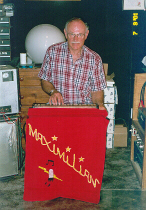 Del Shannon, having already moved to Northridge, California a few years prior, had now moved into the production side of the music field, trying to re-establish fellow contemporary Brian Hyland. Crook had constructed an elaborate home studio, and invited Shannon and Hyland to his home where they began recording more demos. Shannon managed to get Hyland out of his rut with Dot Records, and had Hyland signed to Uni Records. Both Shannon and Hyland were signed to Uni's publishing arm, Trousdale Music. Shannon eventually came up with the idea to re-record Curtis Mayfield's Impressions hit, "Gypsy Woman." Shannon played on and produced the record and lent his vocals to Hyland's new album in 1970. Max played keyboards and Moog synthesizer on the entire album project. "Gypsy Woman" became a Top 5 record in the U.S., and Crook soon found his talents were again in demand. Max went on to include his Moog synthesizer on Liberace's "Autumn Leaves," and began co-writing more songs with Shannon. It was like old times again. Crook co-wrote some fabulous numbers with Del, including "Raylene" and "Love, It Don't Come Easy." The songs have yet to see the light of day. Shannon began touring again in the early 70's. Crook accompanied Shannon on several television appearances including "In Concert" and "Midnight Special." They performed together at the Hollywood Bowl and, in 1973, Crook played on Shannon's "Live In England" LP, an album recorded live in Manchester in December of '72. Shannon returned the favor, plucking guitar on Crook's own "space age" arrangements of "Runaway," "Wheels," and a Crook original, "Razz My Berries." The session was held at The Robbs' Cherokee Ranch Recording Studio in Chatsworth, California in January of 1973, with Shannon in the producer's chair. Scott Ludwig also worked the session with his Moog. Crook continued writing and recording instrumentals, and was approached by film director James Sturgen to write the score for Sturgen's own "Time and Beyond." This became one of Crook's most challenging tasks in music, having to actually create a "synthesized" heavenly choir. The venture was successful, and Crook was gratified with his hard efforts. As a captain for the Ventura Fire Department, Max wrote music to fit slide shows and training films for the department including the now world-wide Incident Command Mutual Aid System. An album was later cut with friends from the fire department and accurately titled "Under Captain Crook." "It sounds slightly silly when you hear the name," explains Max, "because Captain Crook is the name of the McDonald's Policeman -- the cheeseburger dude who chases the Hamburglar." So it started out as a joke, sort of, but became an ongoing gag with the guys. They would continue to give me these "Captain Crook" figurines that came out of those Happy Meals. It was a gas." The album "Under Captain Crook" contained a Crook vocal composition titled "Jellybeans," a tribute to then- U.S. President, Ronald Reagan. A Salvation Army-type number, "Jellybeans" was a patriotic novelty about Reagan and his jellybean eating sweet tooth. One of the members of Max's "Country Congregation" had the privelege of performing the number for the President, and Crook had pictures taken of the event. A publishing conflict with one of the members of the group caused the composition to go unreleased on a national basis. Enjoying the art of writing novelty tunes, Crook wrote a number titled "Happy Haven Resthome" which received second prize at a Dr. Demento National Contest. "It's a silly demented song alright," chuckles Max today. "It's about a guy who wears a brown trenchcoat and 'surprises' the resthome ladies at bridge club." Max retired from the fire department in the 80's and changed his music direction to that of gospel and spiritual music. "My son David is a minister. We are now a tight family as far as the Christianity thing goes, and this just seemed like the right thing for me to do." Thus, Christian music became the next chapter in Max's life. 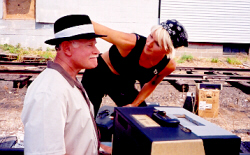 In the late 1980's, Crook recorded and released an album titled "Good News!" which featured, among himself, friends from his church congregation. The most popular number from the album was "Jesus Still Makes Housecalls," which actually received some good airplay on the gospel radio networks. Another song off the album was "Don't Kiss The Devil," a track written and recorded by Max Crook and Mayf Nutter. Crook remembers how the writing of the song came about: "Mayf, a friend from the old days at the Hi-Lo, came to visit, and went to church with us one Sunday. After hearing the sermon that day, Mayf was inspired. We got back to my place and we began writing the song together with a pad and pencil out in the middle of the desert. When we finished it, we came back inside and into my studio where we immediately recorded it. One day, bam! It was done." Max confessed that some songs he would write in 10 to 20 minutes, while others may take as many months to write. "I do fine when writing music for a song, the instrumentation and all. But I have never been a good lyricist. I need help when writing the words to a song. Instrumentals are really my bag." 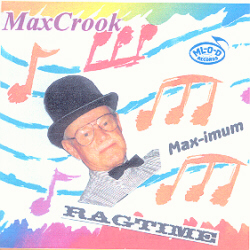 Crook pursued his interest in praise and worship with his wife, Glenda until his passing. He had constructed a studio beside his home in Deming, New Mexico where he resided for the past 25 years. He continued to record music with members of his new church. He and "White Bucks" friend, Stan Martin, along with Martin's wife Pat, have recorded a marriage counseling album, appropriately titled "Standing Pat." Crook produced the album as well as lending music accompaniment and co-writing two of the ten tracks that appear. Max made the annual trip to Michigan each July with his first wife, Joann, to rendezvous with old friends and relatives in Kalamazoo, Ann Arbor, Harbor Springs, and Canton, followed in August by attending the Del Shannon Summerfest in Coopersville, where Crook met with fans and shared his stories of the heyday and sign autographs. Accompanying him on his trips was the infamous Musitron, which he enjoyed playing for the appreciative crowd. Article written by Brian C. Young for delshannon.com For more about Max Crook, read the Chicago Tribune Article: What Ever Happened To Max Crook"? Read Jim Clash's article about Max in Forbes: Where Was Del Shannon's 'Runaway' Written, Recorded? |
|
HOME | WHAT'S NEW? | BIOGRAPHY | DISCOGRAPHY | PHOTOS | SOUND RUNAWAY | MERCHANDISE | FAN CLUB | CONTACT US | GUESTBOOK | LINKS © delshannon.com is Copyright 1998-2024 Del Shannon Enterprises, Inc. All Rights Reserved. |